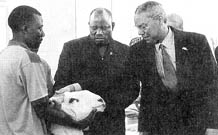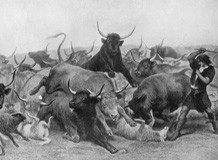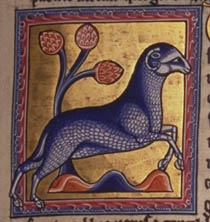History
page under construction
Religion

 The Agnus Dei (Latin
for "Lamb of God") may appear in several
postures. Seated on a book with seven seals, it represents the final
judgment when Christ returns in glory. Rev.
5:11 Then I looked and heard the voice of many angels, numbering thousands
upon thousands, and ten thousand times ten thousand. They encircled
the throne and the living creatures and the elders. 12 In a loud voice
they sang: "Worthy
is the Lamb, who was slain, to receive power and wealth and wisdom
and strength and honor and glory and praise!"
The Agnus Dei (Latin
for "Lamb of God") may appear in several
postures. Seated on a book with seven seals, it represents the final
judgment when Christ returns in glory. Rev.
5:11 Then I looked and heard the voice of many angels, numbering thousands
upon thousands, and ten thousand times ten thousand. They encircled
the throne and the living creatures and the elders. 12 In a loud voice
they sang: "Worthy
is the Lamb, who was slain, to receive power and wealth and wisdom
and strength and honor and glory and praise!"
 Standing with a banner, the Agnus Dei represents the risen
Christ who triumphs over death. This symbol is rich in significance.
John the Baptist proclaimed Jesus to be the Lamb of God who takes away
the sin of the world. In the Revelation, Jesus is portrayed as a lamb.
Even in the Old Testament, God's provision of a ram as a substitute sacrifice
for Isaac is an important type of Christ.John
1:29 The next day John saw Jesus coming toward him and said, "Look,
the Lamb of God, who takes away the sin of the world! Gen.
22:9 When they reached the place God had told him about, Abraham built
an altar there and arranged the wood on it. He bound his son Isaac
and laid him on the altar, on top of the wood. 10 Then he reached out
his hand and took the knife to slay his son. 11 But the angel of the
LORD called out to him from heaven, "Abraham! Abraham!" "Here
I am," he replied. 12 "Do not lay a hand on the boy," he said. "Do not
do anything to him. Now I know that you fear God, because you have not
withheld from me your son, your only son." 13 Abraham looked up and there
in a thicket he saw a ram(n) caught by its horns. He went over and took
the ram and sacrificed it as a burnt offering instead of his son. 14
So Abraham called that place The LORD Will Provide. And to this day it
is said, "On the mountain of the LORD it will be provided."
Standing with a banner, the Agnus Dei represents the risen
Christ who triumphs over death. This symbol is rich in significance.
John the Baptist proclaimed Jesus to be the Lamb of God who takes away
the sin of the world. In the Revelation, Jesus is portrayed as a lamb.
Even in the Old Testament, God's provision of a ram as a substitute sacrifice
for Isaac is an important type of Christ.John
1:29 The next day John saw Jesus coming toward him and said, "Look,
the Lamb of God, who takes away the sin of the world! Gen.
22:9 When they reached the place God had told him about, Abraham built
an altar there and arranged the wood on it. He bound his son Isaac
and laid him on the altar, on top of the wood. 10 Then he reached out
his hand and took the knife to slay his son. 11 But the angel of the
LORD called out to him from heaven, "Abraham! Abraham!" "Here
I am," he replied. 12 "Do not lay a hand on the boy," he said. "Do not
do anything to him. Now I know that you fear God, because you have not
withheld from me your son, your only son." 13 Abraham looked up and there
in a thicket he saw a ram(n) caught by its horns. He went over and took
the ram and sacrificed it as a burnt offering instead of his son. 14
So Abraham called that place The LORD Will Provide. And to this day it
is said, "On the mountain of the LORD it will be provided."
Politics

The
New York Times, May 21, 2001. "Secretary of State Colin L. Powell
was given a ram yesterday in Mali..".
Art

"The
Overthrow" by Rosa BonHeur, lithographic reproduction of the painting
shown at the World's Columbian Exhibition in Chicago in 1983. The sheep
here are clearly the losers, the weaker, less aggressive animals in
the scene.

The
ram or wether from the Aberdeen Bestiary, an
illuminated manuscript from around 1200, in the collection of the Aberdeen
University Library.